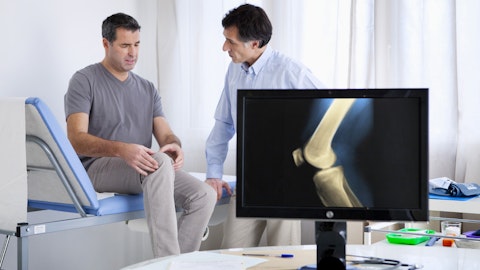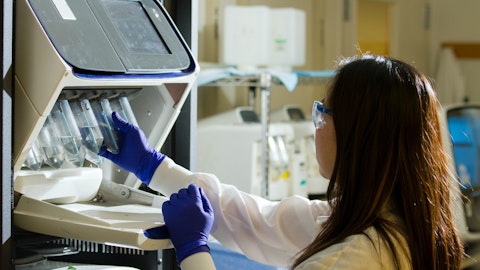Vijay Kumar: Hey, guys. Congrats on the printed. Thanks for taking my question. I had a two-part and I’ll ask them upfront. When you look at Q4, what is changing sequentially here, Karen? Because when I look at 3Q, you did 4% organic despite med sort of declining, continued Diabetes headwinds and China headwinds since Q4. What are these three pieces €“ what are you assuming for those three buckets? And I think you mentioned the renal impact in Q4. Could you specify that? And Geoff, for you, I understand you’re not giving fiscal €˜24 guidance, but when you think about the incremental changes, right, what are the positive tailwinds and negative headwinds? Is China still declining in fiscal €˜24? What happens to Diabetes? Is that on the plus side or minus side? And any other plus or minus at a high level would be helpful.
Karen Parkhill: Yes, Vijay, let me take the first part of your question. In terms of our Q4 revenue ramp, when we gave our second half guidance last quarter, we expected sequential improvement from the third quarter into the fourth quarter. And obviously, we’re still expecting sequential improvement. That’s going to be driven by continued consistency of supply, which we expect, which has already improved across the portfolio and will continue to improve. We also have some recent product launches, like Evolut FX and Hugo, which will continue to ramp. You may recall, we have our harmony Harmony valve, which will return to market as well. And then we’ve also got some launches into new markets, like diabetic neuropathy that will begin to take some hold.
And we’ve got reduced headwinds from things like vents and VBP in the quarter. You asked specifically about Renal Care. We do expect to close that joint venture with DaVita in the fourth quarter. So we simply noted that when we guided so that we didn’t force you all to change your models mid-quarter. We just put it in now. I hope that helps.
Geoff Martha: Just to finish off €“ just to highlight one thing in Karen’s commentary there. A big one will be continued turnaround of our Surgical Innovations business. That was really hit hard, as you guys know, by the supply chain issues. You saw a nice sequential improvement from Q2 to Q3, and you’ll see another improvement from Q3 to Q4. And that €“ Karen mentioned supply chain issues subsiding, a big area where you’ll see that manifested is in Surgical Innovations. When you look at FY €˜24, well, let’s start with some of the known risks. You highlighted China VBP, and we €“ Karen and I already talked about that a bit. That will still be an issue as we go from the 50% of our portfolio that’s done in FY €˜23 to the €“ to another 30% that gives us 80% by the end of FY €˜24.
So that will be a headwind. I don’t know what we’ve said whether China’s growing or shrinking, but it’s definitely not growing at our historic double-digit again next year. The other €“ and look, there is still work to be done on supply chain. I mean it’s €“ our supplier €“ the supply chain out there is still a bit fragile. Although every quarter, it’s getting better for us and €“ but as you look at some of the momentum, like you’ve seen from us from Q1 to Q2, from Q2 to Q3 and then implicit in our guidance is a nice acceleration kind of from Q3 to Q4. So we’re excited about that, happy with the momentum. And as we look into FY €˜24, some of the specific businesses, you mentioned Diabetes. We’re optimistic we’re going to get 780G on the market here in the U.S., and that will have a nice impact on Diabetes plus continued performance in Europe.
So that should be €“ assuming that happens, that should help accelerate some of the growth in Diabetes. Surgical Robotics is doing really well. And as we move into FY €˜24, have a bit more scale and a bit more impact on our numbers. Cardiac Ablation Solutions, I’m sure we will get some questions on our mapping and navigation system as well as our various PFA catheters. You start to €“ we will start to feel some impact from them. And continued strong performance across the Neuroscience portfolio, I think, highlighted the CST or cranial spinal technologies business as well as you’ll see continued strength in ENT. We will anniversary the Intersect acquisition at some point and that goes organic. So those are some of the things that we look at as €“ in FY €˜24.
But it’s €“ there is some, I think, broad supply chain recovery, especially in SI and then a couple of highlights, like I mentioned, CAS, Surgical Robotics, Diabetes in the U.S.
Ryan Weispfenning: Great. Thank you, Vijay. Next question please, Brad.
Operator: The next question comes from Joanne Wuensch at Citi. Joanne, please go ahead.
Joanne Wuensch: Thank you very much and good morning and nice sequential growth there. I have two questions. One is specific to the spine business. It was particularly strong this quarter. And I’m just a little bit curious about what you’re seeing is driving that and how you think about it going forward? And then the other one is a little bit more esoteric. I heard the word urgent or urgently a couple of times throughout the early presentation. What does urgently forging mean and how does that trans to sort of milestones that we can look forward to? Thank you.
Geoff Martha: Well, thanks, Joanne, for the question. Maybe I’ll start with the second one. Look, there is €“ the word urgent, there is a lot of major change that we’ve got going on across the business. And I think it’s important for people to understand the depth and breadth of those changes. And I know there is the desire to see things move quicker. And yes, we’re in some ways, encouraged and we’re encouraged by the progress, but we’d like to see it go faster as well. But the speed of the €“ of our progress of getting the top line growth and adjusting our cost base to reflect the new reality with inflation and FX, on a company our size, the impact of these changes take a bit more time than €“ they take some time. But the actions that we’re taking are €“ we are moving quickly on these.
And I think that’s the idea here. So we’re moving quickly on a number of things, whether be the changes €“ all the investments and changes to our supply chain to the divestitures that we’re working on to the integration of these acquisitions, like Affera and are moving our cash business forward. There is just a lot going on and it’s just important to understand that we’re moving very quickly on these things, and the results are starting, and we’re encouraged by €“ that you’re starting to see the results. When it comes to spine, look €“ was strong. Last quarter was strong too. It was just offset by some of the €“ the last couple of quarters offset a little bit by the China VBP. But if you look underneath it, we have been quoting that U.S. implant growth rates that have been in the double digits, I mean that’s very, very strong and something, especially for some of our level of market share by far, again, the number one market share player to be growing like that.
What’s driving that is the enabling technology ecosystem. It’s something we have been working on aggressively since 2015. You have got the robot, you have got navigation, you have got interoperative imaging, you have got power instruments. Now, you have got this AI-based surgical planning system that basically €“ it’s we are winning over the hearts and minds of physicians as they see where we are going and actually a real commitment to changing spine surgery with this arsenal of technology. And we have integrated it and it’s not €“ it’s starting to help the workflow and move faster and more efficient. All of this coming together, that’s what’s driving it. And at the same time, we have been able to invest in implants, so that the implants were still the latest and greatest.
And I think Brett Wall and Skip Kill and the team have done a really good job. I don’t know, Brett, if you want to make any further comments on that?
Brett Wall: Yes. Geoff and Joanne, thanks for the question. This has been something we have been working on for a while, and the strategy is really coming together with this enabling technology that actually allows for better planning, better execution, better follow-up and assuming and assuring that you actually get the result that you want in the procedure. That technology, along with best-in-class implants and biologics is providing this ecosystem, that’s terrific for the physician and actually institutions that want to use it. And actually, the strategy is playing out like we have wanted to do with the significant growth in the largest market, which is the U.S. And as Geoff mentioned, now we are on the second quarter of double-digit growth there in our core spine business in the U.S. And we like our strategy, technology and how this is playing out for us.
Ryan Weispfenning: Okay. Thanks Joanne. Next question please Brad.
Operator: The next question comes from Matt Miksic at Barclays. Matt, please go ahead.
Matt Miksic: Hi. Thanks so much for taking the question. I had two follow-ups, if I could, just quickly on diabetes and TAVR. So Geoff, your comments this morning, I don’t know if it’s just tone or my own impression, but it seemed like incrementally, perhaps more confident and committed to diabetes and just €“ I know where you are at with the warning letter. But maybe if you could talk about whether you are incrementally more confident here than you were a few months ago and maybe talk about what the reentry to that market looks like, assuming that you can get that €“ the letter lifted and the product back to the market? And then just briefly on TAVR, as you know, one of your major competitors in that market has talked a lot about staffing and trends in the U.S. Just anything that you would add in terms of sequential improvements or changes in that market, or whether you are continuing to see some of the staffing challenges that they referred to, but don’t seem to be holding back your growth quite so significantly in the U.S.?
Thanks.





